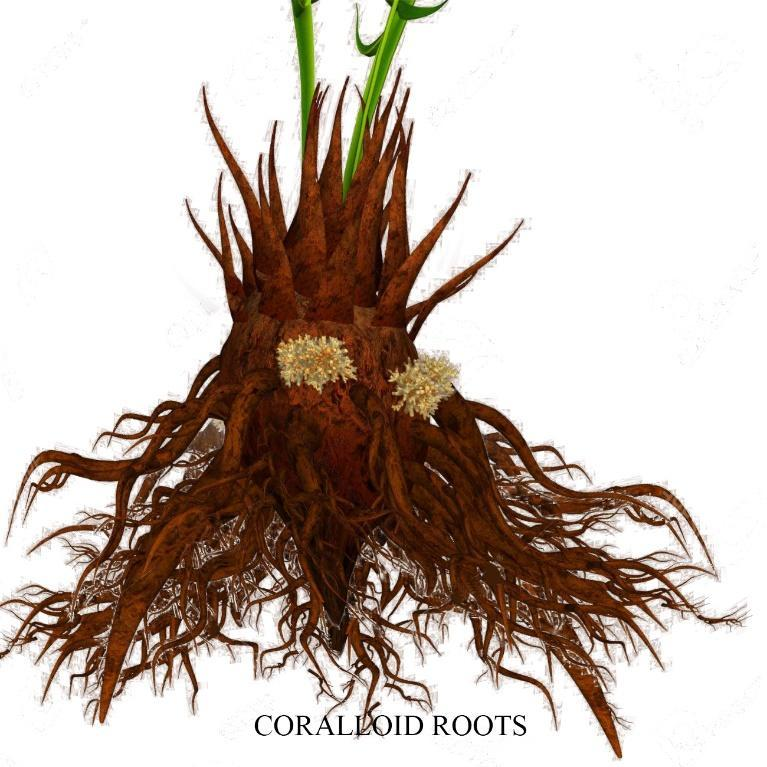
What are coralloid roots?
Answer
438.6k+ views
Hint: Roots are the significant underground part of every single vascular plant. This part of the plant is responsible for mooring the plant down into the ground and absorbing the fundamental mineral components, supplements, and water from the dirt to be able to provide the plant. It is likewise used to store food.
Complete answer:
Coralloid roots are specific roots found in Cycas which are related to nitrogen-fixing cyanobacteria. Inside the coralloid root is the cyanobacterial zone, which is the locale possessed by cyanobacteria. The coralloid roots contain Cyanobacteria, which has a blue-green growth that fixes nitrogen and, in relationship with root tissues, produces advantageous amino acids such as asparagine and citrulline. Coralloid roots of cycads were found to start endogenously from the pericycle of apogeotropic optional roots or extrinsic roots that have been to the surface of the soil. All of the developed coralloid attachments are defenseless to diseases caused by algal endophytes, which appear to enter from the soil through a break in the dermal layers. In the coralloid roots, the green growth possesses intercellular spaces in a zone that emerges from the protoderm, and in which the cells prolong radially following algal disease. The zone is encircled by a determined root cap. The secondary cortex is derived from the root cap.

Note:
The coralloid roots develop blue-green algae that help in nitrogen fixation. Nitrogen fixation is a process by which molecular nitrogen is converted into ammonia that is further used by the plants and microorganisms in their metabolic processes.
Complete answer:
Coralloid roots are specific roots found in Cycas which are related to nitrogen-fixing cyanobacteria. Inside the coralloid root is the cyanobacterial zone, which is the locale possessed by cyanobacteria. The coralloid roots contain Cyanobacteria, which has a blue-green growth that fixes nitrogen and, in relationship with root tissues, produces advantageous amino acids such as asparagine and citrulline. Coralloid roots of cycads were found to start endogenously from the pericycle of apogeotropic optional roots or extrinsic roots that have been to the surface of the soil. All of the developed coralloid attachments are defenseless to diseases caused by algal endophytes, which appear to enter from the soil through a break in the dermal layers. In the coralloid roots, the green growth possesses intercellular spaces in a zone that emerges from the protoderm, and in which the cells prolong radially following algal disease. The zone is encircled by a determined root cap. The secondary cortex is derived from the root cap.

Note:
The coralloid roots develop blue-green algae that help in nitrogen fixation. Nitrogen fixation is a process by which molecular nitrogen is converted into ammonia that is further used by the plants and microorganisms in their metabolic processes.
Recently Updated Pages
Express the following as a fraction and simplify a class 7 maths CBSE

The length and width of a rectangle are in ratio of class 7 maths CBSE

The ratio of the income to the expenditure of a family class 7 maths CBSE

How do you write 025 million in scientific notatio class 7 maths CBSE

How do you convert 295 meters per second to kilometers class 7 maths CBSE

Write the following in Roman numerals 25819 class 7 maths CBSE

Trending doubts
State and prove Bernoullis theorem class 11 physics CBSE

What are Quantum numbers Explain the quantum number class 11 chemistry CBSE

Write the differences between monocot plants and dicot class 11 biology CBSE

1 ton equals to A 100 kg B 1000 kg C 10 kg D 10000 class 11 physics CBSE

State the laws of reflection of light

In northern hemisphere 21st March is called as A Vernal class 11 social science CBSE




